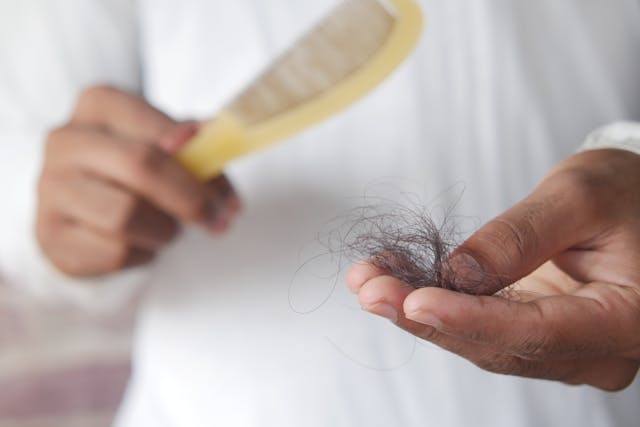The two minute read :

Shedding or Thinning? A Simple Guide
Seeing more hair on your pillow, brush, or in the shower can be worrying.
Some shedding is completely normal, but ongoing thinning might need a closer look.
Here’s how to tell the difference.
Normal Shedding
- Everyone loses about 50–100 hairs a day.
- It’s part of the hair’s natural growth and renewal cycle.
- You might see more hair when brushing, washing, or during seasonal changes.
- If new hairs are growing in, that’s a good sign.
Thinning Hair
Thinning means the hair on your scalp is becoming less dense.
You might notice:
- A wider parting
- The scalp looking more visible in bright light
- A smaller or lighter ponytail
- Hair that looks flat even after washing
Thinning happens when more hairs are lost than replaced, or when new hairs grow back finer and weaker.
Common Causes
- Hormone changes (menopause, thyroid issues, PCOS)
- Genetics (male or female pattern hair loss)
- Low nutrients (iron, vitamin D, zinc, or protein)
- Stress (temporary shedding called telogen effluvium)
- Scalp problems (inflammation or blocked follicles)
(Institute of Trichologists – Hair Loss Conditions{:target=”_blank”})
Quick Checks at Home
- Look for short baby hairs or fine regrowth around the hairline.
- Use natural light to see your scalp more clearly.
- Take a photo every few weeks to track changes.
When to Get Help
See a trichologist if hair loss or thinning lasts more than a few months, or if you notice bald patches or sudden changes.
Find a registered specialist:
👉 Institute of Trichologists – Find a Trichologist{:target=”_blank”}
Remember
Losing some hair is normal.
Most thinning can improve with the right advice, care, and support.
You are not alone — and help is available.
The longer Read :
Shedding or Thinning? How to Spot the Difference
It’s normal to lose some hair every day, but when you start noticing more strands in the shower or on your brush, it’s easy to worry something’s wrong. The truth is, some shedding is completely natural, while thinning can signal that your hair growth cycle needs a little help.
Here’s how to tell the difference and what to do next.
Normal Shedding: Part of the Hair’s Life Cycle
Every single hair on your head goes through a natural cycle of growth, rest, and fall.
On average, you lose 50 to 100 hairs a day, which is part of the body’s normal renewal process
You might notice more shedding when:
- You brush or wash your hair
- You wear it tied up and then take it down
- The seasons change (autumn shedding is common)
If new hairs are growing in to replace the ones that fall out, this is healthy shedding.
Thinning: When Hair Density Changes
Thinning means that the overall amount of hair on your scalp is reducing. You might notice:
- Your parting looks wider than before
- The top of your scalp seems more visible in bright light
- Your ponytail feels smaller or lighter
- Hair looks flatter, even after washing or styling
Thinning happens when more hairs are lost than replaced, or when new hairs grow back finer and weaker.
Common Causes of Thinning
- Hormonal changes such as menopause, thyroid issues, or PCOS can reduce hair density.
- Genetics can cause inherited conditions like male or female pattern hair loss.
- Nutrient gaps such as low iron, vitamin D, zinc, or protein can slow growth.
- Ongoing stress can trigger shedding (telogen effluvium) that takes time to recover.
- Scalp conditions like inflammation or blocked follicles can affect growth.
Simple Ways to Check at Home
- Look for new baby hairs: Short, fine regrowth around the hairline usually means recovery is happening.
- Use natural light: Stand near a window or take a photo of your scalp to see changes more clearly.
- Be consistent: Check the same area over time, not day to day, since hair growth is slow.
When to Seek Help
If shedding or thinning continues for more than a few months, or if you see bald patches or sudden changes, it’s best to speak to a professional.
A trichologist can:
- Examine your scalp and hair health
- Identify possible causes
- Suggest treatment options or lifestyle adjustments
A Gentle Reminder
Hair shedding doesn’t always mean hair loss, and even true thinning can often be improved with the right support and care.
Your hair tells a story about what’s happening inside your body, and listening to it early makes recovery easier.





